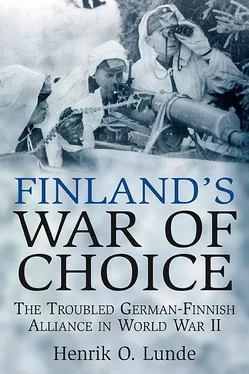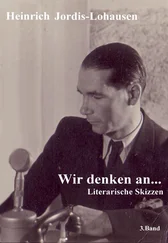The Soviets renewed their demands for the mining concessions in January 1941. The Soviets threatened “to bring order into the situation by the application of certain means” unless the Finns came to a speedy agreement. 35Rather than intervening directly, the Germans managed to cloud the issues by demanding various guarantees with respect to delivery of ore. While the Soviets broke off negotiations and stopped exports to Finland, they avoided an open breach with Germany. The Soviets agreed to provide Germany with their nickel supplies but Hitler believed that they would only keep their promises so long as it suited them. In a meeting with Mussolini on January 18–20, Hitler stated that he would have gone further to support the Finns and that he could not permit further Soviet encroachment on Finland. 36
Early Military Interactions
The picture one gets when reading the accounts of Mannerheim, Ryti, and other high Finnish civilian and military officials is that the Finnish government and its military consistently refused to make any promises or enter into agreements with Germany about a war between Germany and the Soviet Union. This is generally true with respect to the visible and formal side of the relationship between Finland and Germany. There is strong evidence, however, that this formal side did not represent the true situation. Not only were there many meetings between the military of the two countries, but some events and movements of military forces into Finland required considerable preparation which translates into early Finnish acquiescence. It is by examining these events that we get a fuller understanding of the special relationship that existed between the two military establishments.
It is impossible to tell when the special relationship between the two military establishments began. To a large extent it may have existed since World War I. This feeling of comradeship was heavily reinforced by the realization of the Finnish military leaders that only Germany could offer them real protection against the Soviet Union. There was also considerable disappointment—even bitterness—towards the Western powers for not coming to their aid during the Winter War. After the presidential election in December 1940, Finnish foreign policy was controlled by what Olli Vehviläinen describes as an “Inner Circle” in which Mannerheim and Ryti were the leading figures. 37
Whenever the special relationship started, it began to solidify when Veltjens made his visit to Helsinki in August 1940. The transit arrangements that were worked out served both sides. Finland felt more secure from its eastern neighbor since Germany now had a stake in Finland’s well-being. Numerous statements by Finnish politicians and public officials demonstrate this newfound feeling of security. For example, at a New Year’s reception in Berlin the Finnish ambassador told the German secretary of state that he believed Finland would not stand alone in a future conflict with the Soviet Union. There was also an attempt in February, through the military attaché system, to elicit direct German diplomatic support, since another crisis in Finnish–Soviet negotiations appeared to be in the making.
Germany viewed Finland as a route by which to attack the Soviet Union. An entry to this effect is found in the Halder diary on July 22. This was shortly before Hitler made his decision to attack the Soviet Union. The transit agreements served to tie Finland to Germany and the latter, in the words of the German ambassador, was able to establish a line of supply bases in northern Finland.
Otto Meissner, chief of the German Presidential Chancellery, who was a well-informed individual about what was going on, writes in his memoirs: “Rumania and Finland, in a constant state of tension with the Soviet Union, had agreed ahead of time to participate in a possible war.” 38
This early participation of Finland was asserted at the Nuremberg Trials in the form of a deposition from Colonel Kitschmann. Kitschmann was assigned as the German military attaché to Finland from October 1, 1941 when the regular attaché, Major General Rössing, became ill. Kitschmann was briefed on the secret negotiations that had been carried out between the German and Finnish governments and their respective military leaders. His deposition continues:
In the course of these conversations von Albedill [German major on the attaché staff who briefed Kitschmann] told me that as early as September, 1940, Major General Roessing, acting on an order of Hitler and of the German General Staff, had arranged the visit of Major General Talwel [Paavo Juho Talvela 39], the Plenipotentiary of Marshal Mannerheim, to the Führer’s headquarters in Berlin. During this visit an agreement was reached between the German and Finnish General Staffs for joint preparations for a war of aggression, and its execution, against the Soviet Union. In this connection General Talwel told me, during a conference at his staff headquarters in Aunosa in November, 1941, that he, acting on Marshal Mannerheim’s personal orders, had as far back as September, 1940—been one of the first to contact the German High Command with a view to joint preparation for a German and Finnish attack on the Soviet Union. 40
It was probably not just a coincidence that the National Defense Section of the OKW submitted a plan dealing with operations against the Soviet Union to General Jodl on September 19, 1940. The plan assigned a large role to Finland. It is unlikely that planners would have given Finland such a role unless it had been discussed with Finnish military leaders.
Hitler had a conference with Field Marshal Brauchitsch and General Halder on December 5 to discuss what was essentially the latest draft of Operation Barbarossa, the German attack on the Soviet Union. Hitler approved the plan and General Jodl instructed the National Defense Section on December 6 to prepare a directive based on this plan. A meeting between General Nikolaus von Falkenhorst, German Armed Forces commander in Norway, and Halder on December 7 discussed the same plan and here we learn that the Germans planned to use four divisions: two for the Pechenga area and two for the Salla area. The last two would come by rail from central Norway across Sweden. 41
Major General Talvela again appears on the scene. He made a visit to Berlin in the middle of December 1940. The presence of the Finnish general in Berlin in this period caused Ziemke to suggest the possibility that the Finns may have participated in the development of the Barbarossa directive. There is no direct evidence that this was the case although his visit was probably not just a coincidence. The stated reason for Talvela’s visit was to maintain the personal contact between Mannerheim and Göring that had been established by Veltjens.
Talvela had talks with both Göring and Halder and the Finn briefed his hosts on the political and military situation in Finland. We have no information about what else may have been discussed except that Talvela tried to get German support for a political union between Sweden and Finland. Such a union had been agreed to by the Swedes provided Finland gave guarantees that it would not engage in a war of revenge against the Soviet Union. Finland accepted this condition. However, a union of Sweden and Finland ran contrary to German interests. They wanted to keep the north divided in order to maximize German influence. A Swedish-Finnish union would also alleviate Finland’s isolation and undermine German efforts to secure Finnish participation in the attack on the Soviet Union. It was a serious policy mistake by the Soviet Union to also oppose such a union. The German opposition to a union was conveyed to Talvela by Göring.
This was the second attempt to form a Scandinavian military alliance. It had been proposed earlier in 1940 after the Winter War and Norway and Sweden were positive to the idea. The Soviet Union also expressed opposition on this occasion although such a defensive alliance was not specifically prohibited by the Peace of Moscow nor was there a requirement for Finland to seek prior approval by the Soviet Union. A Scandinavian military block may have kept all of Scandinavia out of World War II and spared the Soviet Union from having to worry about the north.
Читать дальше












